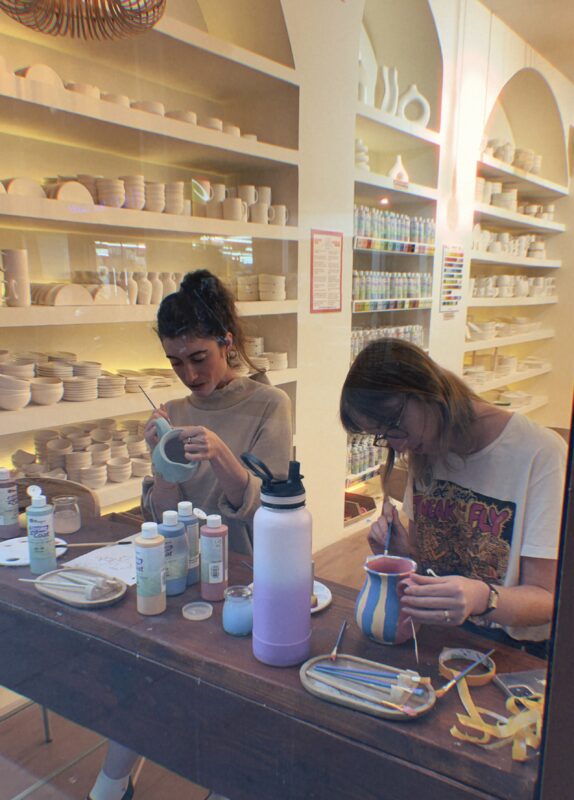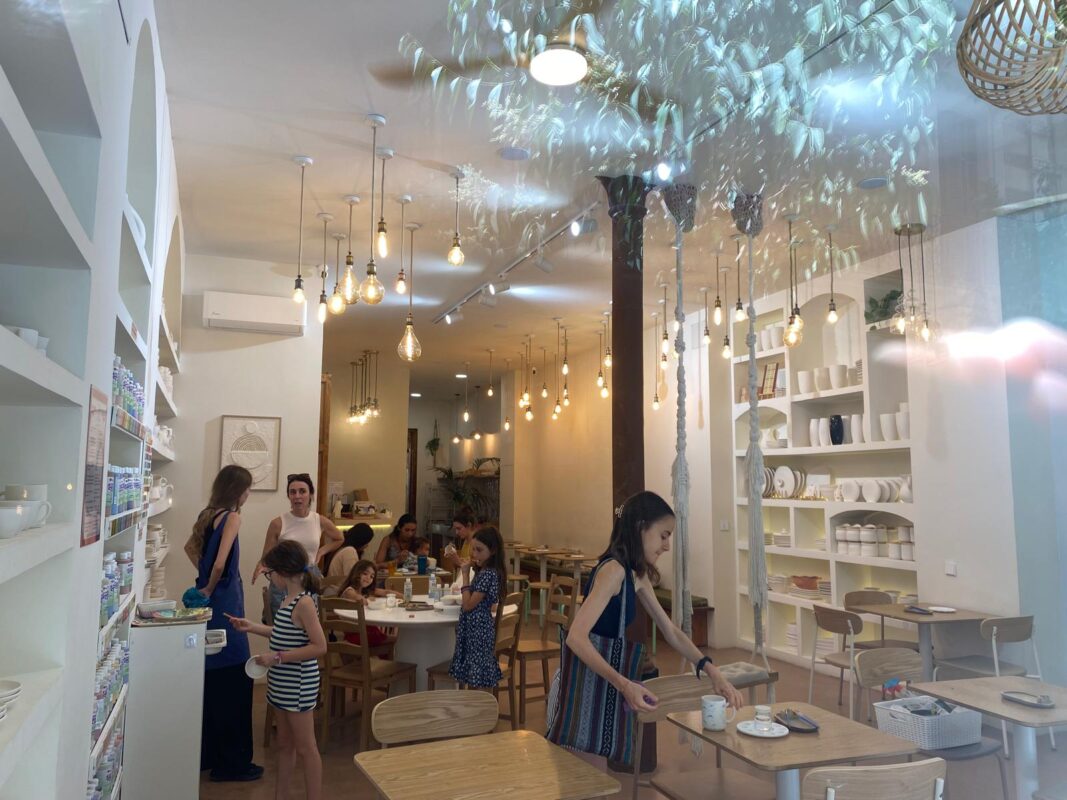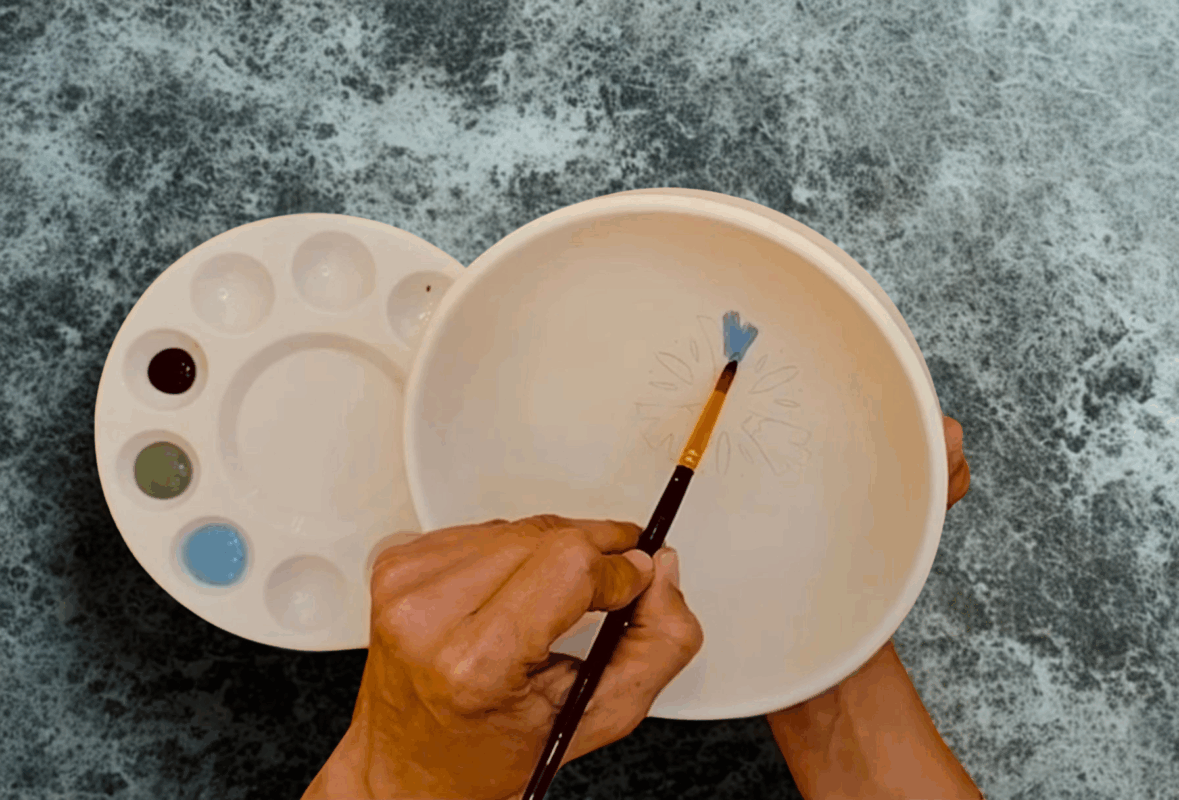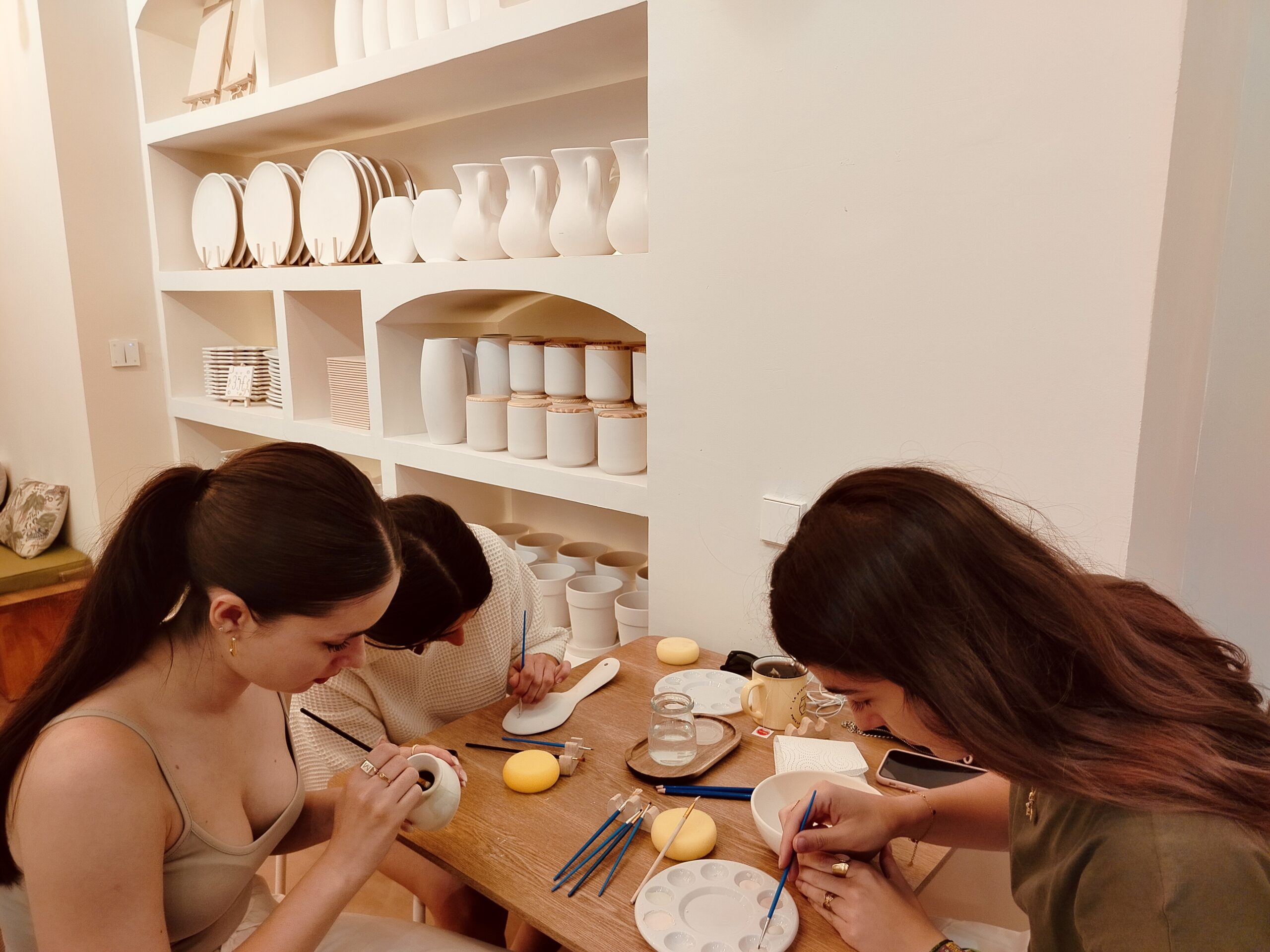Choosing your first ceramic workshop isn’t just about “signing up and that’s it.” It’s about finding a space where you feel comfortable, with materials that inspire you and close, friendly guidance. I’ve been helping people who are starting from scratch — and also those returning to create — for a long time. That’s why here you’ll find clear criteria, per-piece pricing, the real process, and techniques that work. Plus, I’ll explain how we do it at La Pintoràmica: we’re located in Gràcia and opening in the Born on November 1st, with over 100 pieces to decorate and prices starting at €15 (depending on the piece). No experience needed: in a 1h 40min session (100 min) you’ll walk out with your design ready to be fired.
1) Painting, handbuilding, or both? Quick differences to avoid confusion
When people ask me, “is ceramics the same as painting ceramics?”, I always clarify: not exactly.
- Painting on ceramics (what we do at La Pintoràmica) means decorating pre-made pieces —mugs, bowls, plates, figurines— using glazes and pigments. Advantages: results from day one, no clay or wheel involved, and pieces ready to use after firing.
- Handbuilding / wheel throwing means creating the piece from clay. It’s beautiful, but it requires more technique, drying times, and several sessions for just one piece.
When to choose ceramic painting?
If it’s your first time, you want to unplug, come with friends, your partner or your team, and take home something beautiful and useful. In my experience, people who arrive “with no clue” leave delighted because no prior experience is needed.



2) Signs of a good ceramic painting workshop (2-minute checklist)
Before booking, check this:
- Real variety of pieces: minimum 50; ideally 100+. We have 100+ so you can find “yours”.
- Materials inclosos i de qualitat: esmalts, pigments, pinzells i eines ben cuidats (i ben explicats).
- Close guidance: they come to your table, teach you techniques, and answer questions on the spot.
- Clear process: how it’s fired and when you can pick up your piece.
- Flexibility: single sessions, private events, and team buildings.
- Atmosphere: light, wide tables, soft music. It may seem like a detail, but it shows in the final result.
Personal tip: if you’re torn between two pieces, choose the one that “asks” you for a design the moment you see it. The shape suggests colors and strokes, and creativity flows more easily.
3) Price and what's included: how per-piece pricing works (from €15)
In ceramic painting, the price mainly depends on which piece you choose. In our case, from €15 and increases depending on size, shape, and detail.
Often includes:
- Use of the space and materials (glazes, pigments, brushes, stencils, tools).
- Guidance during the session (techniques, color combinations, tips).
- Firing and finishing.
Optional extras (Born):
Starting from the opening in the Born, you'll be able to choose a workshop with cheesecake and a drink (“paint with cake” option) for an additional supplement. The standard option without cake will also be available.
How to optimize your budget
Start with a mug or a bowl: a friendly surface and easy to make shine. When teams come in, I like to suggest a shared color and freedom in the pattern: the result feels cohesive, and each piece keeps its own personality.
Ready to book your session?
Book your ceramic mug painting session →
4) Duration, bookings and pickup: the real process, step by step
- Book online or stop by our space.
- You arrive, choose a piece, and I explain basic techniques (layers, timing, brushes).
- You paint for 1h 40 min (100 min) at your own pace.
- We let it dry, fire it at 1,100 °C with a controlled curve, and email you within 3 days so you can pick up your piece.
I like everything to feel relaxed and unhurried: some people come alone to listen to music and paint; others come as a couple or with family. What matters is enjoying yourself during the session and after, when you use your mug at home.
5) Materials, safety, and how to choose your piece (mugs, bowls, plates)
At La Pintoràmica, we use Mayco Stroke & Coat® as our main color system. When properly fired, it’s food-safe, so you can decorate up to the rim. For a nice and efficient result, we recommend 1–2 coats (usually 2 coats are enough for good opacity without using too much paint).
For signatures and fine lines, we use ceramic pencils; in food-contact areas, these marks remain under a clear glaze so the surface is smooth and comfortable to drink from.
Do I need to leave an unpainted margin on the rim?
With properly fired Stroke & Coat, there’s no need to leave a 1 cm gap. Still, avoid overloading the rim with fine details. If you want a perfect edge, apply painter’s tape, paint, and remove it by touch.
Preparation checklist
- Clean the bisque with a slightly damp sponge (no alcohol or degreasers).
- Color test: shake the jar and make a test stroke in a hidden area.
- Design plan: stencils, tape/masking tape, and stickers if you want silhouettes or masked areas.
- Coats: apply 1–2 thin layers, letting each dry between coats; for softer effects, add a few drops of water.
- Details: lines/signatures with ceramic pencil or fine tip; for pointillism, use the brush tip or nozzles.
- Firing: 1,100 °C following our protocol (we don’t use cold sealants).
If you're not sure what to choose, a mug is perfect to start with: a friendly surface and lots of room for color, text, and minimalist botanical motifs. In my workshops, it's the queen of “first successes”.
6) No experience? Decoration techniques that always work (and how to vary them)
Fail-proof base (3 techniques):
- Sponging: soft backgrounds with light dabs and minimal paint load.
- Pointillism: regular patterns that add volume and rhythm without making it complicated.
- Wet blending: blend two neighboring tones in sections to avoid harsh lines.
Quick “pro-level” variations:
- Sgraffito: paint 2 base coats, let dry, and scratch the design to reveal the color underneath.
- Controlled splatter: using a toothbrush inside a box to avoid stains.
- Marbling: blend neighboring tones to create elegant veins as a base.
- Tape and stencils: stripes, chevrons, grids, and silhouettes with crisp edges when removed by touch.
- Stamps/patterns: repeat motifs color over color (dark over light works especially well).
Workshop tips I always share
- Drying between coats for clean edges and solid color.
- Mistake? If it’s fresh, use a slightly damp sponge; if it has dried, use a soft file (grit 400–600), remove the dust, and repaint in thin layers.
- Error? Si és fresc, esponja lleument humida; si ja s’ha assecat, llima suau (gra 400–600), treu la pols i repinta en capes fines.
7) Real benefits: less stress, more focus and self-esteem while creating
Painting ceramics is a mental reset. I see it every day: focus increases, stress decreases, and that “I feel good here” feeling shows up. There’s also a boost in self-esteem when you see your finished piece; even the “mistakes” often become the favorite detail. I say it a lot: allowing yourself to mess up is part of the process.
8) Gràcia vs. Born: choose your ideal location in Barcelona
- Gràcia: creative neighborhood vibe, perfect for coming after work or strolling around and finishing with some painting.
- Born: we open on November 1st with a delicious new feature: a cheesecake station so you can choose whether to paint with cake and a drink (extra charge) or without cake. Ideal if you’re around the city center and want to combine the session with a foodie or cultural plan.
Personally, I'm excited about the opening in Born: many of you asked for a more central location. If you’ve already visited Gràcia and liked it, you’ll love trying the new space (and if you have a sweet tooth, the cake option too).
9) In groups: private events and teambuildings (what to expect and how to book)
We organize birthdays, friends/family gatherings, and teambuildings for companies. We adapt the duration (100 min), level, and group flow. I like to start with a mini demo and then guide table by table: the goal is to enjoy a creative moment and make sure everyone takes home a useful piece.
Thinking of planning it for your team?
Organize a ceramic team building in Barcelona →
10) Durability and care: dishwasher, microwave, and graceful aging
We fire with a gradual rise to 1,100 °C and cooling inside the kiln (prevents stress and microcracks). The finish is vitrified, durable, and glossy.
- Daily use & dishwasher: with Stroke & Coat and a smooth, continuous surface, pieces hold up very well in a household dishwasher when following our guidelines (avoid abrasives).
- Microwave: safe under normal conditions for vitrified ceramic tableware (no metallic parts). If your design includes metallics or special applications, we’ll let you know at the studio.
11) Tips to spark creativity (inspiration and “allowing yourself to fail”)
- Quick references: nature (leaves, flowers), art (Matisse-style lines), neighborhood details (tiles, typography).
- 70/30 rule: 70% safe base + 30% experiment (new color, stroke, or texture).
- Lightning sketch: 30 seconds of drawing unlock decisions.
- Ritual: come with your playlist or someone who inspires you; the atmosphere is everything.
In my sessions, the best results appear when you stop chasing the “perfect” piece and start creating one that represents you.
12) Frequently Asked Questions
Sí. Està pensat per a principiants i també per a qui ja pinta i vol perfeccionar tècnica.
Fem servir Mayco Stroke & Coat® (color) i llapisos ceràmics per a detalls. En zones de contacte alimentari, els traços fins queden sota esmalt transparent. Després de la cocció a 1.100 °C, és apte per a vaixella.
Amb Stroke & Coat ben cuit no cal reservar 1 cm. Tot i així, evita sobrecarregar el llavi amb microdetalls i busca una superfície llisa per beure còmode.
La sessió dura 1 h 40 min (100 min). T’enviem un email quan la teva peça està llesta i, en 3 dies, ja la pots recollir.
Sí, seguint les nostres pautes: peces vitrificades a 1.100 °C, superfície llisa i sense aplics metàl·lics. Evita productes molt abrasius.
Si és fresc, esponja lleument humida. Si ja s’ha assecat, llima fina (400–600), treu la pols i repinta en capes fines.


